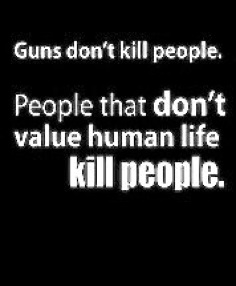Guns Don’t Kill People...
Here are several trivia questions to start the conversation.
First, what do the cities in this very abbreviated list have in common: Austin, Oklahoma City, Newtown, Nice, San Bernadino, Berlin, Paris, New York City?
Then, what is a single factor that distinguishes half of these cities from the other half?
Finally, why is the reaction to that distinguishing factor so radically different on each half?
The answer to the first question is obviously easy. Each of those cities was the site of a massacre of innocent men, women, and children.
The second question takes a little more thought. A quick review of history, however, provides the answer. In four of the cities, the lethal weapons were firearms. In the other four, the killing was done with vehicles.
Now consider some of the details.
On Aug 1, 1966, Charles Whitman, a Marine veteran with an IQ of 139, killed his mother and wife, climbed to the top of the Tower on the University of Texas campus in Austin, shot and killed 14 pedestrians below the tower, and wounded 31 more with his firearms.
Twenty nine years later, on April 19, 1995, Timothy McVeigh parked his explosives laden truck in front of the Alfred P. Murrah federal building in Oklahoma City. The explosion that followed snuffed out the lives of 168 individuals, injured 680 more, and destroyed or damaged much of the block around the Murrah building.
McVeigh claimed to have been bullied in school and considered the government the biggest bully of all. That is why he carried out the most deadly of the massacres mentioned here.
Next in this lineup is Newtown. That is the home of Sandy Hook Elementary School in Connecticut where a young man killed his mother, stole one or more of her weapons, and killed 26 students and teachers before killing himself.
Nice is the French city where, just over a year ago on July 14, a man drove a vehicle into a crowd celebrating the French equivalent of our 4th of July. The carnage total was 86 dead and 458 wounded.
Remember also that San Bernadino, California, was the scene of another mass shooting, and Berlin saw people killed and thrown in the air by a vehicle driven into a Christmas market. Shortly before that, Paris had been the scene of a night club shooting that left 150 dead and 413 wounded.
Finally, the most recent incident of carnage was the truck being driven down the bike path in New York City. The death and injured count was the lowest of the incidents discussed here, but it could have been much higher if the assailant had gotten onto the Brooklyn Bridge, his main target.
After being reminded of what happened in those cities, what is the answer to the third trivia question? Why is the reaction to those tragedies so different?
Half of the tragedies discussed here were the result of gun fire. The other half fell to vehicles used as weapons.
If the deaths and injuries resulted from bullets, the hue and cry is about limiting or controlling weapons ownership. If, however, the destruction resulted from vehicle, which kill many more humans, the complaint is that law enforcement officials were not doing a satisfactory job.
This has to be one of the best examples possible of illogical thinking or reasoning. The firearm weapons could not have killed or injured a single individual without a human being holding the triggers. Likewise, the vehicular weapons could not have hit a single human without another human handling the controls.
So here’s the perspective.

This might be the best example possible of the NRA slogan that guns don’t kill people, people do.
If Senator Diane Feinstein and others think that limiting gun ownership in some manner will reduce the number of murders, how about limiting ownership of vehicles which kill a lot more individuals than guns.
Treating guns and cars the same way would not even put a dent in the problem. If both firearms and vehicles are prohibited, mad men like Whitman and McVeigh will find other ways to wreak their mayhem. Planting pressure cooker bombs like at the Boston Marathon might be among the first choices.
Massacres like the ones discussed here are inevitable. The only practical way to curtail or ameliorate their recurrence is being constantly alert to your surroundings and being willing to report suspicious behavior, even if on the part of a family member, to the authorities.
Keep those eyes, ears, and inquisitiveness open.
enough





